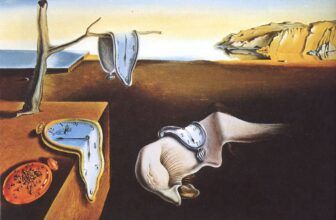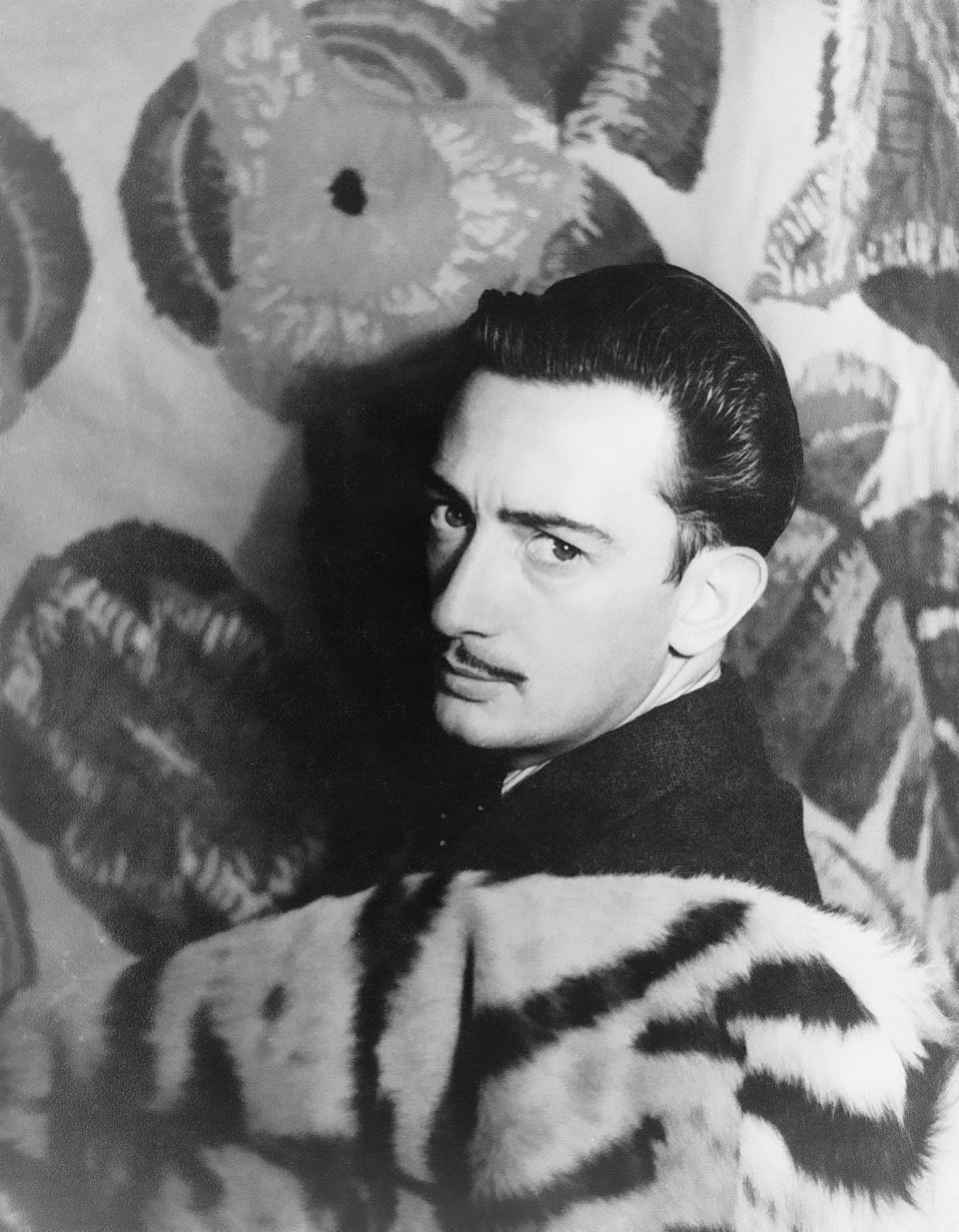
What are Salvador Dali’s Famous Paintings
Few names in art history conjure images as vivid, dreamlike, and bizarre as Salvador Dalí. The eccentric Spanish painter , with his razor-sharp mustache, theatrical personality, and mind-bending creativity , became one of the most famous artists of the 20th century. His paintings are not merely works of art; they are windows into the subconscious, laced with symbolism, personal mythologies, and surreal landscapes where time melts, elephants grow impossibly tall legs, and human forms morph into objects.
Dalí’s genius wasn’t limited to the brush. He was a master self-promoter, a provocateur, and a consummate storyteller. This blend of vision and performance made his art both instantly recognizable and endlessly discussable.
Below, we explore Dalí’s top 10 most famous paintings, weaving together their meanings, symbols, locations, historical context, fascinating facts, and market value.
1. The Persistence of Memory (1931)
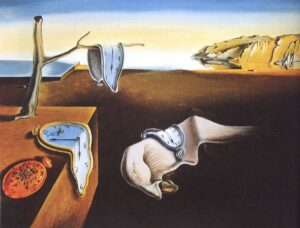
The Persistence of Memory Painting
Location: The Museum of Modern Art (MoMA), New York City
Estimated Value: Over $150 million (never sold, considered priceless)
Description:
Perhaps the most famous of all surrealist works, The Persistence of Memory depicts a desolate coastal landscape , inspired by Dalí’s native Catalonia , where soft, melting clocks drape over tree branches, a ledge, and a strange biomorphic form. The scene is eerily still, illuminated by an unnatural light.
Meaning & Symbolism:
- Melting clocks represent the relativity of time, possibly inspired by Albert Einstein’s theory, though Dalí himself claimed the idea came from watching Camembert cheese melt in the sun.
- The ants swarming one clock symbolize decay and the inevitable destruction of material things.
- The dreamlike coastline is a nod to Dalí’s hometown of Port Lligat.
Fun Fact: Dalí painted this in just a few hours, during a self-described “hallucinatory state of clarity.”
2. The Elephants (1948)
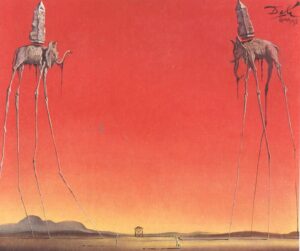
The Elephants Painting
Location: Private collection (paintings with similar imagery appear in multiple museums)
Estimated Value: $25–40 million (based on comparable sales)
Description:
Two elongated elephants stride across an empty desert, each carrying an obelisk on its back. Their impossibly long, spindly legs contrast sharply with the heavy burden they carry.
Meaning & Symbolism:
- Elephants traditionally symbolize strength and power, but Dalí’s stretched legs create an unsettling fragility.
- The obelisk references Bernini’s sculpture in Rome, linking to themes of immortality and history.
- The surreal contrast between heaviness and lightness reflects the tension between the spiritual and the material world.
Fun Fact: Dalí often reused the elephant motif in later works, calling it “a creature beyond the laws of nature.”
3. Swans Reflecting Elephants (1937)
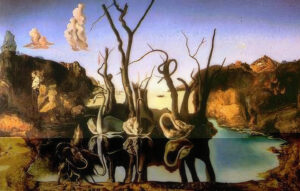
Swans Reflecting Elephants Painting
Location: Private collection
Estimated Value: $30–50 million
Description:
A calm lake in Catalonia reflects a line of swans. But in the mirror image, their necks and the trees behind them form the shapes of elephants , a striking example of Dalí’s “double image” technique.
Meaning & Symbolism:
- Swans symbolize grace and beauty, while elephants represent power and permanence.
- The reflection trick plays with the idea of duality: things are not always what they appear.
- Painted during the Spanish Civil War, the work may reflect Dalí’s views on transformation and uncertainty.
Fun Fact: This was inspired by Dalí’s fascination with Sigmund Freud’s theories of the unconscious and optical illusions.
4. Metamorphosis of Narcissus (1937)
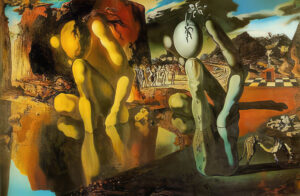
The Metamorphosis of Narcissus painting
Location: Tate Modern, London
Estimated Value: Over $60 million
Description:
Dalí reimagines the Greek myth of Narcissus. On one side, the figure of Narcissus kneels beside a pool, gazing at his reflection. On the other, the same form is transformed into a stone hand holding an egg, from which a flower emerges.
Meaning & Symbolism:
- The egg symbolizes birth and transformation.
- The hand suggests the sculpting power of time and fate.
- The myth’s theme , falling in love with one’s own image , is updated into a meditation on change, death, and rebirth.
Fun Fact: Dalí considered this his first fully “paranoiac-critical” work, a method he claimed could tap into subconscious creativity.
5. The Sacrament of the Last Supper (1955)
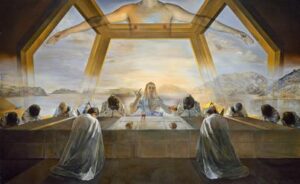
The Sacrament of the Last Supper painting salvador dali
Location: National Gallery of Art, Washington, D.C.
Estimated Value: $20–30 million
Description:
Dalí’s reinterpretation of Leonardo da Vinci’s Last Supper features Christ at the center of a luminous, geometric room. His body is transparent, and the Apostles sit around a glass-like table.
Meaning & Symbolism:
- Transparency reflects the divine merging with the spiritual.
- The dodecahedron (12-sided figure) surrounding the scene symbolizes harmony and the universe.
- The work bridges Renaissance symmetry with surreal spirituality.
Fun Fact: Critics were divided , some saw it as kitsch, others as a masterpiece of modern religious art.
6. Galatea of the Spheres (1952)
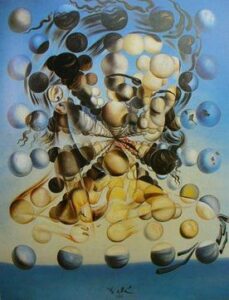
Galatea of the Spheres painting salvador dali
Location: Dalí Theatre-Museum, Figueres, Spain
Estimated Value: $15–25 million
Description:
The portrait of Dalí’s muse and wife, Gala, is broken into floating spheres, resembling molecular particles suspended in space.
Meaning & Symbolism:
- Spheres reflect Dalí’s post-atomic fascination with quantum physics after WWII.
- Gala appears as both a human and a cosmic being, linking love with the universal structure of matter.
Fun Fact: Dalí once claimed: “Everything is made of spherical units of energy.”
7. Dream Caused by the Flight of a Bee Around a Pomegranate a Second Before Awakening (1944)
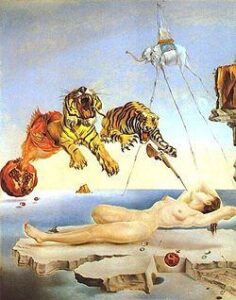
Dream Caused by the Flight of a Bumblebee around a Pomegranate a Second Before Awakening
Location: Thyssen-Bornemisza Museum, Madrid
Estimated Value: $20–35 million
Description:
Gala floats nude above a rocky shore, as a pomegranate splits open. From it, a fish leaps, followed by two tigers and a bayonet, all seemingly seconds from striking her.
Meaning & Symbolism:
- Inspired by Freud’s analysis of dreams.
- Bee represents the stimulus in the waking world; the rest is the mind’s rapid dream construction.
- Pomegranate symbolizes fertility, love, and mythological origins.
Fun Fact: Dalí called it “a super-realistic dream painted in daylight.”
8. The Hallucinogenic Toreador (1969–1970)
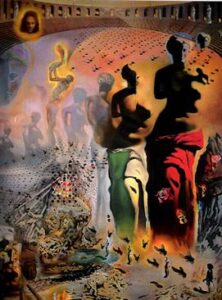
The Hallucinogenic Toreador Painting salvador dali
Location: Dalí Museum, St. Petersburg, Florida
Estimated Value: $40–60 million
Description:
A massive, complex canvas where the image of a Spanish bullfighter is hidden in repeated depictions of the Venus de Milo. The background bursts with colors and surreal juxtapositions.
Meaning & Symbolism:
- Toreador represents Spanish culture and Dalí’s mixed feelings about bullfighting.
- Venus de Milo serves as both beauty and the figure’s clothing folds , a visual puzzle.
- The painting combines personal memory, politics, and optical illusion.
Fun Fact: Dalí began this after being inspired by a box of Venus de Milo chocolates.
9. Leda Atomica (1949)
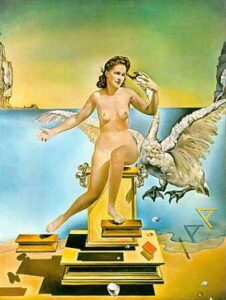
Leda atomica painting salvador dali
Location: Dalí Theatre-Museum, Figueres, Spain
Estimated Value: $20–30 million
Description:
Dalí’s wife, Gala, poses as Leda from Greek mythology, with all surrounding objects , including the swan , floating in mid-air, untouched by gravity.
Meaning & Symbolism:
- Reflects Dalí’s obsession with atomic theory, where matter never actually touches.
- The mythological theme connects divine love and scientific precision.
Fun Fact: Every element’s placement was calculated according to mathematical ratios.
10. Christ of Saint John of the Cross (1951)
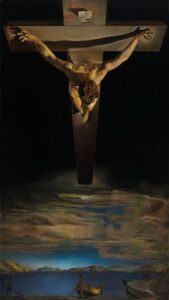
Christ of Saint John of the Cross Painting
Location: Kelvingrove Art Gallery and Museum, Glasgow
Estimated Value: $60–80 million
Description:
A dramatic overhead view of Christ on the cross, suspended over a dark seascape. There are no nails, blood, or crown of thorns.
Meaning & Symbolism:
- Depicts a spiritual, rather than suffering, Christ.
- Inspired by a 16th-century sketch by Saint John of the Cross.
- Dalí claimed the composition came to him in a dream.
Fun Fact: When Glasgow bought it in 1952 for £8,200, it caused outrage , now it’s considered one of the UK’s greatest art acquisitions.
Dalí’s Genius in Context
These works span Dalí’s career, from his early surrealist experiments to his later fusion of science, religion, and myth. A few threads run through them all:
- Catalonian Landscape: Many backgrounds echo Port Lligat and Cadaqués, grounding his surreal visions in real geography.
- Psychological Symbolism: From Freud’s dream analysis to his own “paranoiac-critical” method, Dalí mined the unconscious for imagery.
- Technical Precision: Despite their dreamlike subject matter, his paintings are meticulously detailed, almost photographic.
The Market for Dalí’s Work
While Dalí produced thousands of paintings, prints, and sculptures, his top works are mostly in museums. This means they are rarely (if ever) sold, and their “value” is largely theoretical. However, Dalí’s major paintings in private hands can command tens of millions at auction.
- Highest auction record: Portrait de Paul Éluard (1929) sold for $22.4 million in 2011 , but experts agree his true masterpieces would fetch $100M+ if they ever came to market.
- Dalí’s prolific output has also led to a flood of prints and forgeries , authentication is crucial.
Dalí’s Enduring Legacy
What makes Dalí unique is not just the imagery , the melting clocks, the dreamscapes, the impossible animals , but his complete embrace of art as life. He blurred the boundaries between reality and imagination, between science and myth, between genius and absurdity.
Visiting these paintings in person is a surreal experience in itself. Standing before The Persistence of Memory at MoMA, for example, you realize how small it is , just 9.5 x 13 inches , yet how vast its impact has been on modern culture.
In Dalí’s own words:
“I don’t do drugs. I am drugs.”
And perhaps that’s the best explanation of all for the visions he gave us , wild, intoxicating, and impossible to forget. images /wikipedia / Moma


